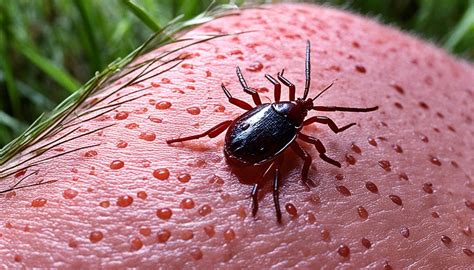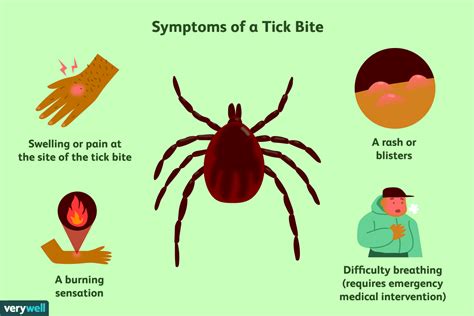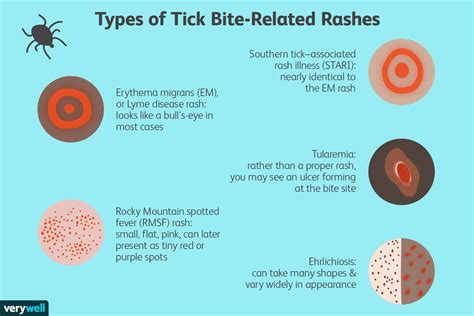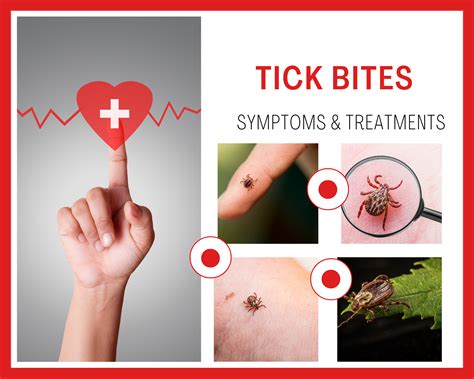Intro
Identify tick bite infection symptoms, including fever, rash, and joint pain, and learn about Lyme disease, tick-borne illnesses, and prevention methods to protect against these biting insect-borne diseases.
Tick bites can be a significant concern for individuals who spend time outdoors, particularly during the warmer months. These tiny arachnids can transmit a variety of diseases, including Lyme disease, Rocky Mountain spotted fever, and Southern tick-associated rash illness (STARI), among others. Understanding the symptoms of tick bite infections is crucial for prompt medical attention and effective treatment. In this article, we will delve into the importance of recognizing tick bite infection symptoms, the potential risks associated with tick bites, and the measures that can be taken to prevent these infections.
The importance of recognizing tick bite infection symptoms cannot be overstated. Tick-borne illnesses can range from mild to severe, and in some cases, they can be life-threatening if left untreated. For instance, Lyme disease, which is the most common tick-borne illness in the United States, can cause fever, headache, and a distinctive rash in its early stages. If not treated promptly, Lyme disease can lead to more severe symptoms, including arthritis, neurological problems, and heart issues. Therefore, it is essential to be aware of the symptoms of tick bite infections and seek medical attention immediately if any of these symptoms are experienced.
Tick bites can occur anywhere, but they are more common in areas with tall grass, brush, and leaf litter. Ticks can attach to humans or animals and feed on their blood, potentially transmitting diseases during this process. The risk of tick bite infections varies by region, with certain areas having a higher incidence of tick-borne diseases. For example, the northeastern United States is a high-risk area for Lyme disease, while the southeastern United States is a high-risk area for Southern tick-associated rash illness (STARI). Understanding the risks associated with tick bites in your area can help you take necessary precautions to prevent these infections.
Types of Tick Bite Infections

There are several types of tick bite infections, each with its unique set of symptoms and treatment options. Some of the most common tick-borne illnesses include Lyme disease, Rocky Mountain spotted fever, and Southern tick-associated rash illness (STARI). Lyme disease is the most common tick-borne illness in the United States, causing an estimated 30,000 cases each year. The symptoms of Lyme disease can vary, but they often include fever, headache, and a distinctive rash. Rocky Mountain spotted fever is another tick-borne illness that can cause fever, headache, and rash, as well as abdominal pain, vomiting, and muscle pain. Southern tick-associated rash illness (STARI) is a less common tick-borne illness that causes a distinctive rash, as well as fever, headache, and fatigue.
Symptoms of Tick Bite Infections
The symptoms of tick bite infections can vary depending on the specific disease transmitted. However, there are some common symptoms that can indicate a tick bite infection. These symptoms include: * Fever and chills * Headache and fatigue * Rash or lesion at the site of the tick bite * Muscle and joint pain * Swollen lymph nodes * Abdominal pain and vomitingCauses of Tick Bite Infections

Tick bite infections are caused by the transmission of diseases from ticks to humans or animals. Ticks can become infected with these diseases when they feed on the blood of infected animals, such as deer or rodents. When an infected tick attaches to a human or animal, it can transmit the disease through its saliva. The risk of tick bite infections is higher in areas with a high population of ticks and infected animals.
Risk Factors for Tick Bite Infections
There are several risk factors that can increase the likelihood of tick bite infections. These risk factors include: * Spending time outdoors in areas with tall grass, brush, and leaf litter * Not using protective clothing, such as long-sleeved shirts and pants * Not using insect repellent or tick repellent * Not conducting regular tick checks after spending time outdoors * Living in areas with a high population of ticks and infected animalsDiagnosis of Tick Bite Infections

The diagnosis of tick bite infections typically involves a combination of physical examination, medical history, and laboratory tests. A healthcare provider may perform a physical examination to look for signs of a tick bite, such as a rash or lesion. They may also ask questions about the patient's medical history, including any recent outdoor activities or travel. Laboratory tests, such as blood tests or skin biopsies, may be used to confirm the diagnosis of a tick-borne illness.
Treatment Options for Tick Bite Infections
The treatment options for tick bite infections vary depending on the specific disease transmitted. Antibiotics are often used to treat tick-borne illnesses, such as Lyme disease and Rocky Mountain spotted fever. In some cases, hospitalization may be necessary to treat severe symptoms or complications. It is essential to seek medical attention immediately if any symptoms of tick bite infections are experienced.Prevention of Tick Bite Infections

Preventing tick bite infections is crucial to reducing the risk of tick-borne illnesses. There are several measures that can be taken to prevent tick bites, including:
- Using protective clothing, such as long-sleeved shirts and pants
- Using insect repellent or tick repellent
- Conducting regular tick checks after spending time outdoors
- Avoiding areas with tall grass, brush, and leaf litter
- Using tick-repellent clothing or gear
Importance of Tick Bite Prevention
Preventing tick bite infections is essential to reducing the risk of tick-borne illnesses. Tick-borne diseases can have serious consequences, including long-term health problems and even death. By taking measures to prevent tick bites, individuals can reduce their risk of contracting a tick-borne illness and protect their overall health.Conclusion and Future Directions

In conclusion, tick bite infections are a significant concern for individuals who spend time outdoors. Understanding the symptoms of tick bite infections, the potential risks associated with tick bites, and the measures that can be taken to prevent these infections is crucial for prompt medical attention and effective treatment. By taking measures to prevent tick bites and seeking medical attention immediately if any symptoms are experienced, individuals can reduce their risk of contracting a tick-borne illness and protect their overall health.
What are the most common symptoms of tick bite infections?
+The most common symptoms of tick bite infections include fever, headache, and a rash or lesion at the site of the tick bite. Other symptoms may include muscle and joint pain, swollen lymph nodes, and abdominal pain and vomiting.
How can I prevent tick bite infections?
+Preventing tick bite infections involves using protective clothing, such as long-sleeved shirts and pants, using insect repellent or tick repellent, conducting regular tick checks after spending time outdoors, and avoiding areas with tall grass, brush, and leaf litter.
What should I do if I experience symptoms of a tick bite infection?
+If you experience symptoms of a tick bite infection, seek medical attention immediately. A healthcare provider can diagnose and treat the infection, reducing the risk of long-term health problems and complications.
We hope this article has provided you with a comprehensive understanding of tick bite infection symptoms, causes, and prevention measures. If you have any further questions or concerns, please do not hesitate to comment below. Share this article with your friends and family to raise awareness about the importance of tick bite prevention and prompt medical attention. Take the necessary steps to protect yourself and your loved ones from tick-borne illnesses and stay safe outdoors.
